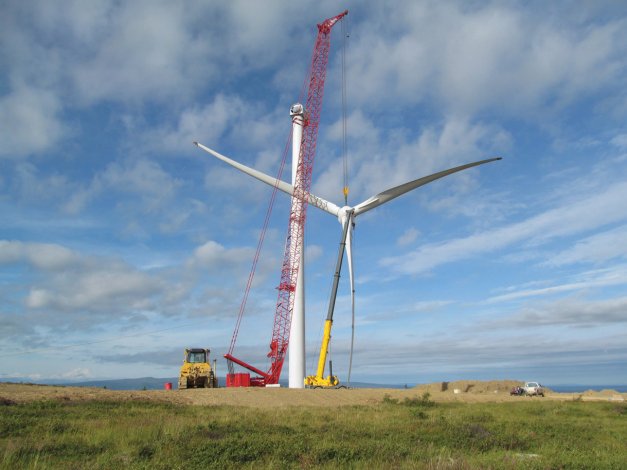Renewable energy projects, benefits emerge in rural Alaska

A rotor for one of the 12 wind turbines is moved into position at the Eva Creek wind project near Healy. The project began generating power last fall, and the Golden Valley Electric Association estimates it will offset some $4 million in fuel costs for its members over the year.
Photo/Courtesy/Golden Valley Electric Cooperative
Alaska’s rural energy problems have seemed hopeless at times, but there’s now a ray of hope on the horizon: If things stay on track, renewable energy projects being built mostly in small rural villages could be saving up to 26 million gallons of fuel per year by 2018.
At a typical fuel price of $4 a gallon, that’s more than $100 million per year in cash that will stay in rural villages, most of which are now economically hard-pressed.
Fuel prices are higher than $4 per gallon in many small villages, which means the savings will be greater.
Those benefits will increase over time because more projects will move into the queue behind those scheduled to be operating by 2018.
Sean Skaling, the Alaska Energy Authority’s director for alternative energy, said the state’s investment in small community projects over five years is now approaching a quarter of a billion dollars.
The benefits from fuel savings are now beginning to show up as projects move from the drawing boards into construction and completion.
Skaling briefed several hundred people April 29 attending the annual Rural Energy Conference, which was held in Anchorage April 29 through June 1.
The Legislature approved another $25 million in funding for the state’s Renewable Energy Fund program this spring, and if Gov. Sean Parnell approves that appropriation it will bring total REF funding to $227 million, Skaling said.
The amounts being invested are actually higher because local project developers must provide matching funds, and other agencies like the Denali Commission and the U.S. Department of Agriculture’s rural development program also contribute.
The state is also investing substantial sums in renewable energy projects serving larger communities.
State funds have gone to support Cook Inlet Region Inc.’s Fire Island and Golden Valley Electric Association’s Eva Creek wind projects, and state investments are being made in planning for the large Watana-Susitna hydro project on the upper Susitna River.
As for rural Alaska, local municipalities, tribal governments, rural utilities like Alaska Village Electric Cooperative, and in some cases private utilities, propose projects for grants under the REF’s annual “rounds” for project funding.
Five rounds over five years have been held so far, the sixth has just been approved by the Legislature, and proposals for a seventh round will be accepted by AEA beginning in September, Skaling said.
In 2012, the Legislature extended authorization for the REF program another five years, although appropriations are made year-to-year.
What is significant is that after five years more projects are moving from engineering to construction, Skaling said.
Eighty-two percent of the projects funded through in the first five years of the REF are now in construction, he said. Sixty-two of the grants from the first five years of the Rural Energy Fund are now “closed out,” meaning the projects are in operation.
The fuel savings seem modest so far, estimated at 3.3 million gallons of diesel annually in 2012.
That will accelerate, however.
Emily Ford, spokeswoman for the Alaska Energy Authority, said the mix of projects now in construction includes more small- to medium-sized hydro projects, which will generate a substantial amount of power. But those also take more time to design and construct, Ford said.
In contrast, many of the projects actually completed so far are wind power projects that are typically built faster than projects like hydro but offer more modest savings in fuel.
However, even the 62 projects completed so far will have a substantial long-term economic benefit.
The Vermont Energy Institute, contracted by AEA to look at the REF program, estimated the 62 projects, built with $112 million in state funds matched with other investment have a Net Present Value of $500 million in economic benefits over the life of the projects.
Skaling highlighted some of the recently completed projects. At Atka, in the Aleutians, a 283-kilowatt hydro project at Chuniisax Creek completed in 2012 will meet 100 percent of the community’s electricity needs along with some of those of Atka Pride Seafoods, a local fish processing plant.
The project cost $5 million with funds from the REF and other sources, and will save 52,000 gallons of fuel that otherwise would have been used to generate power, Skaling said.
There is additional potential for fuel savings if excess power from Atka’s hydro project can be used to heat buildings electrically.
At Falls Creek, a small hydro project at Gustavus, $750,000 in grants from the REF were combined with other funds raised to build a $10.1 million project that will save 140,000 gallons of fuel annually.
A wood biomass project for a school at Delta, in Interior Alaska, cost $2.8 million with $2 million from the REF.
Wood chips are used to heat the school, resulting in an annual fuel savings of 53,000 gallons.
“This allowed the school is save two teacher positions, restart the school music program and remodel the kitchen,” Skaling said.
Another, smaller wood biomass project at the Haines Senior Center is exceeding its performance goal.
The installation cost $225,000 with $189,000 from the REF, and its annual fuel savings has exceeded 50,000 gallons, up from 38,000 gallons estimated originally.
Tim Bradner can be reached at tim.bradner@alaskajournal.com.